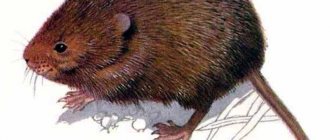Often unexpected guests appear in the country house or garden - pests. It can be quite problematic to remove them, and they create serious problems - they can eat sprouts, destroy root crops, and they can also move into your home.
Rats reproduce quite quickly, so the problem must be addressed immediately after detection. Small holes in the beds will indicate that this is where the dwelling is located. It can go about 35 cm deep. Getting the animals can be difficult.
How to get rid
There are various methods for eliminating such neighbors from the garden. The main thing is to remember that if there are pets or children walking on the site, then you need to protect them as much as possible from the influence of rodents. You can try to scare away rats or get rid of them altogether. Repellent methods:
- Pungent smell. Vishnevsky's ointment is diluted in a container with water and the ground where the animal's burrow is supposedly located is used. They cannot stand such a smell, so they can either change place or leave.
- Needles. Spruce needles scattered along the route of pests will help repel them for a while, since they touch their paws and injure them.
- Ash. You can also sprinkle paths with ash. It burns the animal's skin, so it will retreat.
Before moving on to methods of extermination, it is best to try to scare away the rats. The animals can go to a safe place and no longer cause trouble.
Ground rat in the garden: photo
Ground dogs in the garden: photo.
Name: Water vole, European water rat Lat.:
Arvicola amphibiusClass: Mammals - Mammalia Order: Rodents - Rodentia Family: Hamsters - Cricetidae
| Habitats: | banks along ponds, fields and gardens |
| Nutrition: | bark and roots, bulbs, small mammals, insects |
| Peculiarities: | semi-aquatic lifestyle, life in a large colony |
Traps
The first device with which a person fought rodents was a trap or trap. Modern devices of this type have already been transformed into more efficient devices.
You can make traps yourself or buy ready-made traps. Once there, the rat dies immediately. But recently, the “smart” animal has learned to bypass them.
In order to not give rodents a chance to appear at your dacha, you need to work hard when harvesting, completely clean the entire area, and not leave any leftover food for them. Loud sounds also scare away animals; you can make a device out of tin cans, which will play a role in the wind.
But in general, if an unexpected guest appears, you must immediately begin to fight him. After all, this will help to avoid serious problems in the future.
Appearance of the animal
The appearance of the animal is more similar to mice than to rats:
- rounded body, large head with a blunt muzzle;
- small round ears, barely noticeable;
- the eyes are round and large enough;
- massive paws with long toes and slightly rounded claws.
There are still differences between rats and mice. The rodent's body length is about 22 cm. The tail is narrow, long, covered with thick, hard hair. There is a small brush at the tip. The coat is soft, but there are long, stiff fibers throughout the body. In winter, the cover becomes denser and fluffier. The weight of the animal is about 350 g.
https://www.youtube.com/watch?v=i4mxY6U7hr0
The abdomen is dirty white. Available in red or completely black. The yellow earthen rat looks like a hamster. The only thing that gives it away is its long tail and the absence of a light stripe along the back. A photo of an earthen rat is presented below.
Earth rat
Differences from other rodents
The ground rat differs from the gray rat in having soft fur and a shorter tail without ring scales.
They differ from moles in the smaller size of their underground passages, which also have an irregular shape. Also, rats do not hibernate in winter.
The tracks are similar to the prints of gray voles, but have a longer step length - 6-8 cm.
To compare the ground rat with other rodents, we suggest reading about pied voles, the mole vole, the red and banked voles, and the root vole.
Lifestyle
The rodent is active all year round , spending almost all its time underground in winter. By time of day, the greatest activity is concentrated in the evening and at night.
It emerges from the hole only for a short period of time, moving away a short distance - as a rule, while eating plants on the ground.
In summer during the greatest heat and in winter it clogs burrows from the inside . The earth produced by digging passages is thrown to the surface, forming small, flat piles of varying sizes and at varying distances from the exit point.
Underground passages are located 10-15 cm from the ground surface . The nest usually consists of an extensive network of labyrinths, a nesting chamber and several storehouses with supplies.
REFERENCE! If moles live near the habitat of an earthen rat, then they can use the moles’ ready-dug passages to quickly get to the roots and tubers.
Humane means
Successful fight against earth rats can also be carried out using methods that are more gentle for the animals and do not involve their physical destruction. These methods are based on forcing rats to leave their favorite places.
Modern methods include the use of high-frequency sound vibrations. Ultrasonic repellers come in two types: some are effective in open spaces and indoors, and the second are aimed against rodents living underground.
By spreading ultrasonic vibrations directly into the ground, they repel earth rats. The advantage of this method is its ease of use. The disadvantage is the relative high cost.
Folk recipes
Earth rats do not tolerate proximity to chamomile.
Folk recipes for exterminating rats are considered less effective, but safer for family members, pets and crops. The most effective include the following:
- Growing plants. The roots of black elderberry release cyanide into the soil, poisoning rats, coniferous plants with needles injure them, burdock sticks to the skin and interferes. It is also worth planting plants that have an unpleasant odor for pests: garlic, mint, hazel grouse, tansy, wormwood, chamomile, juniper;
- Smoking. You will need to burn mint, wormwood or old rubber before entering the holes. The latter can be left for several days after burning. A sharp, unpleasant stench will force mice to run away.
- Use of gasoline and kerosene. It is necessary to wet pieces of rags and place them in front of the holes; you can also pour a glass of fuel inside. They note that the method gives almost instant results, but it must be used carefully, since gasoline spoils the soil and groundwater.
Basic methods of struggle
You can fight a rat in various ways. For example, a pest can be caught, driven out, poisoned. The choice of the most optimal method depends on the number of parasites, as well as on the personal preferences of the owners of the land. The main methods are chemical, mechanical and biological. The main advantage of these methods is that all individuals are completely destroyed, and the result is quick. However, sometimes it is much easier to simply drive the rodents out.
Such a rat digs holes in the soil no worse than a mole
Description of the pest
Field rat in the garden.
The ground rat is actually a mouse, a water vole, which is actually a member of the hamster family. This mammal is called a rat because of its appearance. It is slightly larger than all its relatives, but smaller than the muskrat, the largest of them.
The water vole has a large body, a short muzzle and short legs. The tail can be 2/3 of the length of the rat’s entire body, the maximum size of which reaches 25 cm. The fur can differ in shades depending on the region and period, from brownish-gray to pure black. There is also a small amount of fur on the tail.
You can get to know the water vole better in this article.
Life activity
The ground rat has some qualities that you should be aware of. They damage lands and even agriculture on a large scale. Water voles reproduce quickly and are very fertile. They have 5 cubs in each offspring, and they give birth 2-3 times a year.
They are absolutely gluttonous . They eat almost everything they come across. These are small fish or shellfish, frogs or even chicks. They do not shy away from seeds and small root vegetables; they love bark and roots. On hungry days, they do not disdain even their small relatives, field mice.
Water voles are hyperactive . They are active both day and night. They are equally agile underground, in trees and in water. They can drag all the food that can be preserved into their pit to lie there during the hungry period.
Colonies and individual animals carry various diseases that can be dangerous for children and animals. They carry viruses and diseases, many dangerous diseases. Moreover, infection occurs directly through a bite, but also through feces and contaminated dust.
Pests, although active, are also cunning. For example, they get along well with moles. Earth rats love to use their passages and even steal supplies.
Rats get along with moles.
Distribution and reproduction
The ground rat can be found in the European part of the country, the Caucasus, and Siberia (except for the regions of the Far North). A large number of rodents are concentrated in the south of Siberia and Central Asia.
It chooses damp places to live - along the banks of reservoirs, swamps and damp meadows. When the population is high, it can colonize gardens, fields and orchards.
During floods, it migrates, moving to drier and more convenient places to live.
REFERENCE! Often lives in populated areas, settling in personal plots and creating passages in thin walls and under the floor.
In the southern regions, under comfortable conditions, the ground rat can reproduce all year round. In other places, the process occurs from spring to autumn, two or three times.
The number of individuals in the litter depends on the life span of the animal - the older the female, the more cubs she can bear . The offspring are bred underground, in a separate equipped place.
When they reach the age of one month, the young begin to live independently.
Under optimal conditions, the number of ground rats increases several times, and their number can reach 400 animals per hectare of field.











